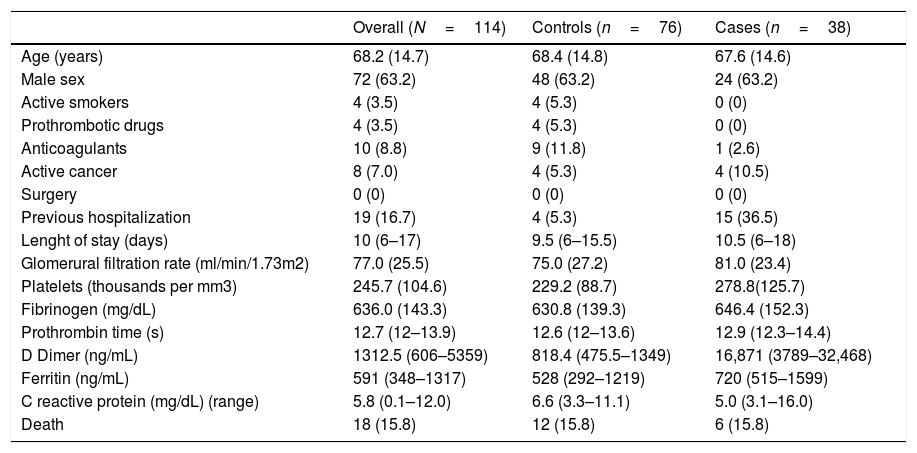D-dimer levels are elevated in COVID 19 and they correlate to the levels of other inflammatory markers such us ferritin, fibrinogen and C-reactive protein. It may be possible to correct D-dimer value in function of inflammatory markers, thus identifying patients at higher risk of venous thromboembolism (VTE). Our objectives are estimating a corrected value of plasma D-dimer as a linear function of ferritin, C-reactive protein and fibrinogen and stablishing a cut-off point of high probability of VTE.
Patients and methodsAge and sex matched case-control study of all patients diagnosed with COVID 19 and VTE between March and May 2020 in a tertiary hospital in Madrid (Spain). Using linear regression, the best predictive model will be estimated and residual D-dimer values will be obtained and analyzed using ROC curves to determine its discriminative performance.
ResultsThirty-eight cases and seventy-six controls were included. There was 63.2% of men and mean age was 68.2. D-dimer was best predicted by a linear model including fibrinogen, ferritin and C-reactive protein. Using residual values, the optimal cutoff point was 2165ng/mL, with a sensitivity of 57.9% and specificity of 98.7%.
ConclusionIt is possible to estimate a D-dimer corrected value in function of ferritin, C-reactive protein and fibrinogen. Using the observed and estimated value we can obtain a residual value that performs well as a screening method to detect patients who would benefit for further VTE diagnostic testing.
El dímero-D está elevado en la COVID-19 y se correlacionan con los niveles de otros marcadores inflamatorios como ferritina, fibrinógeno y proteína C reactiva. Cabe la posibilidad de corregir el dímero-D en función de dichos marcadores inflamatorios, identificando así los pacientes con mayor riesgo de enfermedad tromboembólica venosa (ETV). Nuestros objetivos son estimar un valor corregido de dímero-D como función lineal de ferritina, proteína C reactiva y fibrinógeno, y establecer un punto de corte de alta probabilidad de ETV.
Pacientes y métodosEstudio de casos y controles emparejados por sexo y edad de todos los pacientes diagnosticados con COVID-19 y ETV entre marzo y mayo de 2020 en un hospital terciario de Madrid, España. Mediante regresión lineal, se estima el mejor modelo predictivo y se obtiene el valor residual de dímero-D. Este se analizará con curvas ROC para determinar su capacidad discriminativa.
ResultadosSe incluyeron 38 casos y 76 controles. Había un 63,2% de varones y la edad media fue de 68,2 años. El valor de dímero-D fue predicho por un modelo que incluyó fibrinógeno, ferritina y proteína C reactiva. Usando los valores residuales, el punto de corte óptimo estimado de 2.165ng/ml, con una sensibilidad del 57,9% y una especificidad del 98,7%.
ConclusionesEs posible estimar un valor corregido de dímero-D en función de ferritina, fibrinógeno y proteína C reactiva. Usando el valor observado y estimado podemos obtener un valor residual que funciona bien como método de cribado para detectar pacientes que podrían beneficiarse de más estudios diagnósticos de la ETV.











